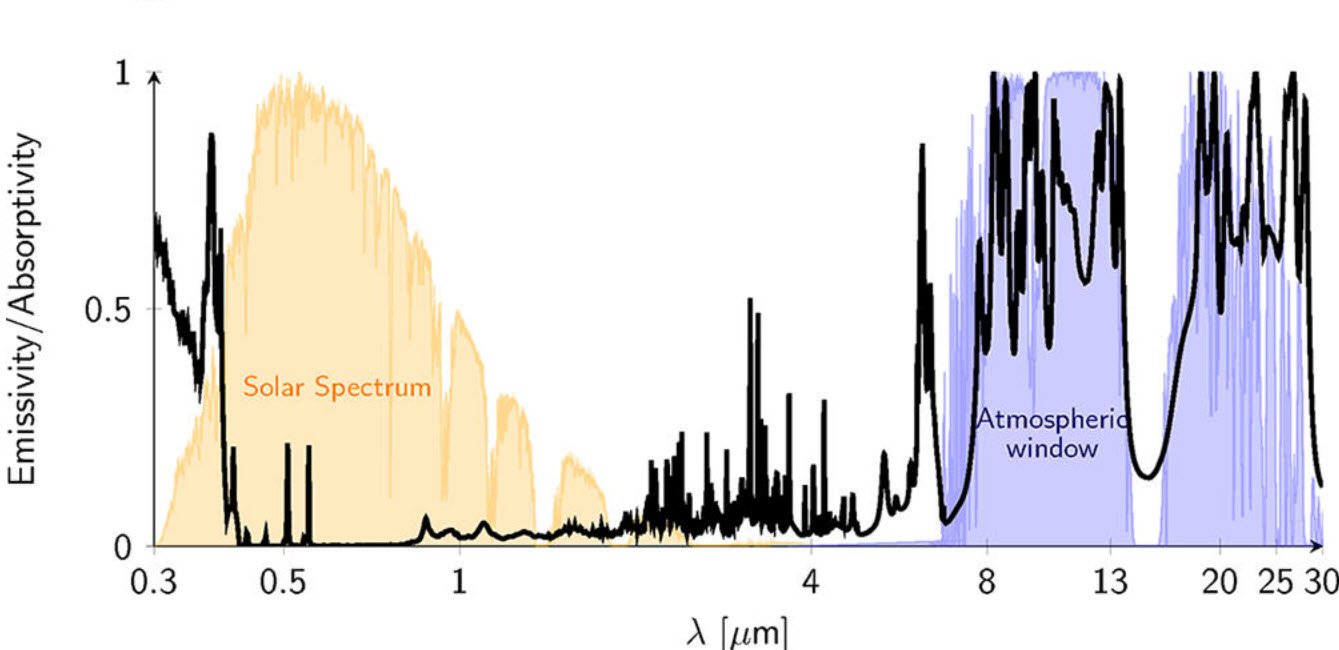New solar structure cools buildings in full sunlight, replacing air conditioners
March 29, 2013

(Credit: Sumd/Wikimedia Commons)
Stanford University researchers have designed an entirely new form of cooling structure that cools even when the sun is shining, eliminating the need for air conditioning.
Such a structure could vastly improve the daylight cooling of buildings, cars, and other structures by reflecting sunlight back into space.
“We’ve developed a new type of structure that reflects the vast majority of sunlight, while at the same time it sends heat into that coldness, which cools manmade structures even in the day time,” explained Shanhui Fan, professor of electrical engineering and senior author of a Nano Letters paper.
The trick: (1) the reflector has to reflect as much of the sunlight as possible and (2) the structure also must efficiently radiate heat back into space — that is, within a specific wavelength range in which the atmosphere is nearly transparent.

Emissivity/absorptivity (black line) of the new cooling structure. It achieves optimized cooling by having minimal absorption (maximum reflection) throughout the solar spectrum (yellow) and very strongly selective emission in the thermal atmospheric transparency window (blue,~7 to 30 microns) (credit: Eden Rephaeli et al./Nano Letters)
The new structure accomplishes both goals. It serves as an effective broadband mirror for solar light; that is, it reflects most of the sunlight. It also emits thermal radiation very efficiently within the crucial wavelength range needed to escape Earth’s atmosphere.
Outside this range, Earth’s atmosphere simply reflects the light back down (a.k.a. the greenhouse effect — the cause of global climate change).
Nanostructured photonic materials
“No one had yet been able to surmount the challenges of daytime radiative cooling — of cooling when the sun is shining,” said Eden Rephaeli, a doctoral candidate in Fan’s lab and a co-first-author of the paper. “It’s a big hurdle.”
The Stanford team has succeeded where others have come up short by turning to nanostructured photonic materials. These materials can be engineered to enhance or suppress light reflection in specific wavelengths.

Optimized daytime radiative cooler design with two thermally emitting photonic crystal layers comprised of SiC and quartz. Below that is a broadband solar reflector containing three sets of five bilayers made of MgF2 and TiO2 with varying periods on a silver substrate. (Credit: Eden Rephaeli et al./Nano Letters)
“We’ve taken a very different approach compared to previous efforts in this field,” said Aaswath Raman, a doctoral candidate in Fan’s lab and a co-first-author of the paper. “We combine the thermal emitter and solar reflector into one device, making it both higher performance and much more robust and practically relevant. In particular, we’re very excited because this design makes viable both industrial-scale and off-grid applications.”
Using engineered nanophotonic materials, the team was able to strongly suppress how much heat-inducing sunlight the panel absorbs, while it radiates heat very efficiently in the key frequency range necessary to escape Earth’s atmosphere. The material is made mainly of quartz and silicon carbide, both very weak absorbers of sunlight.
Net cooling power
The new device is capable of achieving a net cooling power in excess of 100 watts per square meter. By comparison, today’s standard 10-percent-efficient solar panels generate the about the same amount of power. That means the radiative cooling panels could theoretically be substituted for existing solar panels on rooftops, which feed electricity to air conditioning systems to cool the building.
Radiative cooling has another profound advantage over all other cooling strategies, such as air conditioners. It is a passive technology. It requires no energy. It has no moving parts. It is easy to maintain. You put it on the roof or the sides of buildings and it starts working immediately.
A typical one-story, single-family house with just 10 percent of its roof covered by radiative cooling panels could offset 35 percent its entire air conditioning needs during the hottest hours of the summer.
Beyond the commercial implications, Fan and his collaborators foresee a broad potential social impact. Much of the human population on Earth lives in sun-drenched regions huddled around the equator. Electrical demand to drive air conditioners is skyrocketing in these places, presenting an economic and an environmental challenge. These areas tend to be poor and the power necessary to drive cooling usually means fossil-fuel power plants that compound the greenhouse gas problem.
“In addition to these regions, we can foresee applications for radiative cooling in off-the-grid areas of the developing world where air conditioning is not even possible at this time. There are large numbers of people who could benefit from such systems,” Fan said.